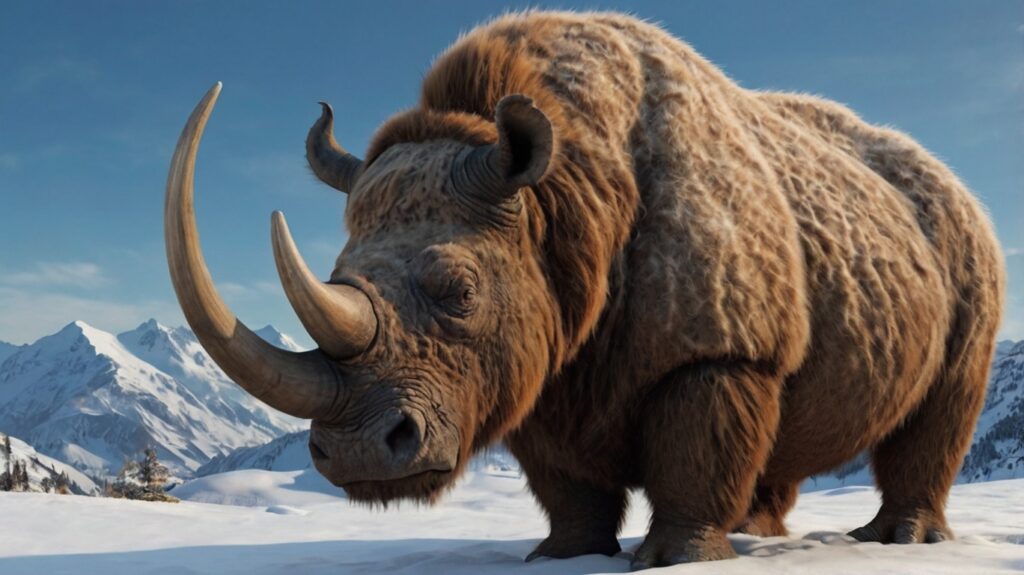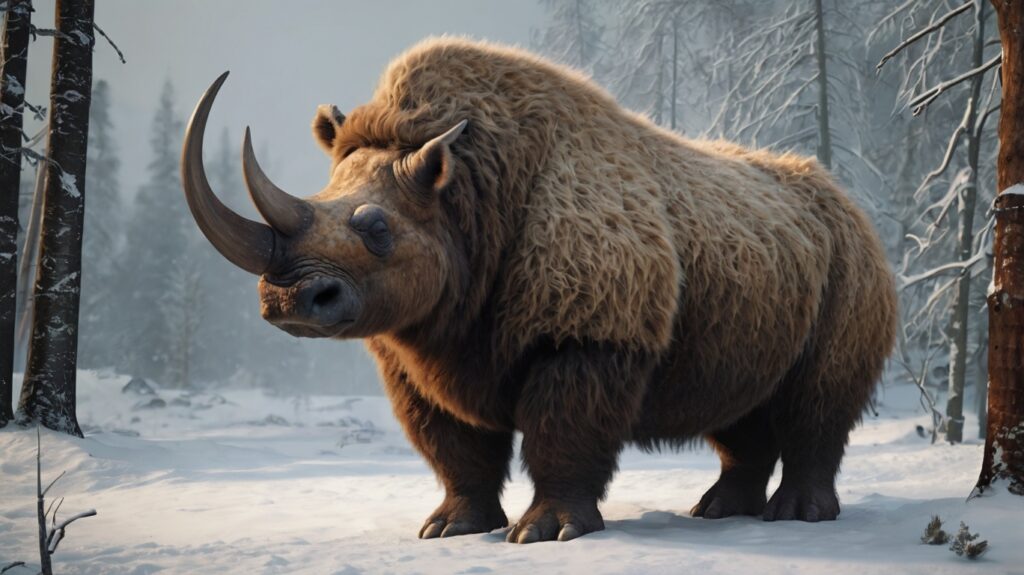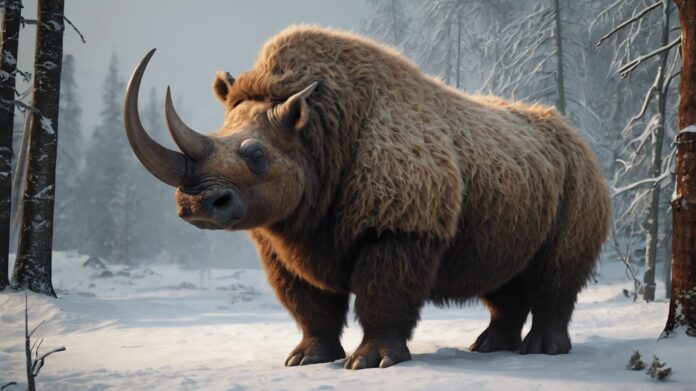
Imagine a world covered in ice, where giant creatures roamed the land. One of these incredible animals was the woolly rhinoceros. This fascinating creature lived during the Ice Age and Let’s take a journey back in time to learn more about this amazing animal.
The World of the Woolly Rhinoceros
The woolly rhinoceros, also known as Coelodonta antiquitatis, lived around 2.6 million to 10,000 years ago. It roamed the icy plains of Europe and Asia. The world was much colder then, and huge ice sheets covered large parts of the earth. The Pleistocene epoch refers to this time frame.
What Did They Look Like?
The woolly rhinoceros was similar in size to the modern rhinoceros but covered in thick, shaggy fur. This thick fur helped them stay warm in the freezing temperatures. They also had a layer of fat under their skin for extra insulation.
Their bodies were strong and stocky, perfect for moving through snow and ice. They had two large horns on their noses. The front horn was bigger, sometimes growing up to three feet long! These horns were likely used for digging in the snow to find food and for fighting off predators.
Adaptations for Survival
Living in such a harsh environment meant the woolly rhinoceros had to have some special adaptations:
- Thick Fur: As mentioned, their thick, woolly fur helped them stay warm.
- Horns: Their large horns were not just for show. They were tools for survival, used to dig through snow to reach the plants they ate.
- Big Nostrils: They had large nostrils to warm the cold air before it reached their lungs.
- Stocky Build: Their strong bodies helped them move through the tough terrain of the Ice Age.
What Did They Eat?
The woolly rhinoceros was a herbivore, meaning it ate plants. Even though the world was cold, there was still plenty of vegetation for them to eat. They grazed on grasses, leaves, and shrubs. During the winter, they used their horns to dig through the snow to find food.
The Ice Age Neighbors
The woolly rhinoceros shared its world with many other amazing creatures. Some of their neighbors included:
- Woolly Mammoth: Another iconic animal of the Ice Age, known for its long, curved tusks and thick fur.
- Saber-Toothed Tiger: A fierce predator with long, sharp teeth.
- Cave Lions: Large, powerful lions that hunted in the icy plains.
- Early Humans: Yes, humans lived during this time too! Early humans would have seen the woolly rhinoceros and even hunted them for food and fur.
Discovering the Woolly Rhinoceros
How do we know so much about an animal that lived so long ago? Scientists have found many fossils and remains of the woollys rhinoceros. These discoveries have been made in places like Siberia, where the cold conditions helped preserve their bodies.
In some cases, entire carcasses have been found, with skin, fur, and even organs still intact. These finds are like time capsules, giving us a direct glimpse into the past.
The Importance of the Woolly Rhinoceros
The woolly rhinoceros is more than just an ancient animal; it helps us understand the world of the Ice Age. By studying their remains, scientists learn about the climate, the environment, and the other animals that lived during that time. This knowledge helps us understand how life on Earth has changed and adapted over millions of years.
Why Did They Go Extinct?
Like many Ice Age animals, the woolly rhinoceros eventually went extinct. A few theories exist as to why this occurred:
- Climate Change: As the Ice Age ended, the climate became warmer. The cold-loving woolly rhinoceros may not have been able to adapt to the changing environment.
- Human Hunting: Early humans hunted the woollys rhinoceros for food and fur. As human populations grew, this hunting pressure may have contributed to their decline.
- Competition for Food: As the climate warmed, other animals may have moved into their habitat, creating competition for food.
What Can We Learn From Them?
The story of the woolly rhinoceros teaches us about the delicate balance of nature. It shows how animals adapt to their environment and how changes in climate can have a huge impact on life. It also reminds us of the impact humans can have on other species.

Bringing the Past to Life
Today, you can see models and reconstructions of the woollys rhinoceros in museums around the world. These displays help bring the past to life, showing us what these magnificent creatures looked like and how they lived.
Conclusion
The woolly rhinoceros was a remarkable animal, perfectly adapted to the harsh conditions of the Ice Age. With its thick fur and powerful horns, it roamed the icy plains, sharing its world with other incredible creatures. Although it went extinct thousands of years ago, the woolly rhinoceros continues to fascinate us and teach us about our planet’s history.
By studying animals like the woolly rhinoceros, we gain a better understanding of how life on Earth has evolved and adapted. It also reminds us of the importance of preserving the natural world and the delicate balance that exists in nature. The woollys rhinoceros may be gone, but its story lives on, a testament to the wonders of the Ice Age and the incredible diversity of life on our planet.
FAQs about the Woolly Rhinoceros
1. What did the woolly rhinoceros eat?
The woolly rhinoceros was a herbivore, meaning it ate plants. Its diet mainly consisted of grasses, leaves, and shrubs. During the winter months, it used its large horns to dig through snow to find food.
2. How big was the woolly rhinoceros?
The woolly rhinoceros was almost the same size as contemporary rhinos. It could grow up to 12 feet long and stand about 6 feet tall at the shoulder. They were sturdy and well-built, which helped them survive in the harsh Ice Age environment.
3. Where did the woolly rhinoceros live?
The woolly rhinoceros lived in the cold, icy regions of Europe and Asia during the Ice Age. Fossils and remains have been found in areas such as Siberia, which suggests they were well-adapted to extremely cold climates.
4. Why did the woolly rhinoceros go extinct?
There are several theories about why the woolly rhinoceros went extinct. The main reasons include climate change at the end of the Ice Age, which led to warmer temperatures and a changing environment, human hunting for food and fur, and increased competition for food from other animals.
5. How do scientists know about the woolly rhinoceros?
Scientists have learned about the rhinoceros through fossils and remains found in places like Siberia. In some cases, entire carcasses have been discovered with skin, fur, and even organs intact, preserved by the cold. These finds provide valuable insights into what the woolly rhinoceros looked like and how it lived.

